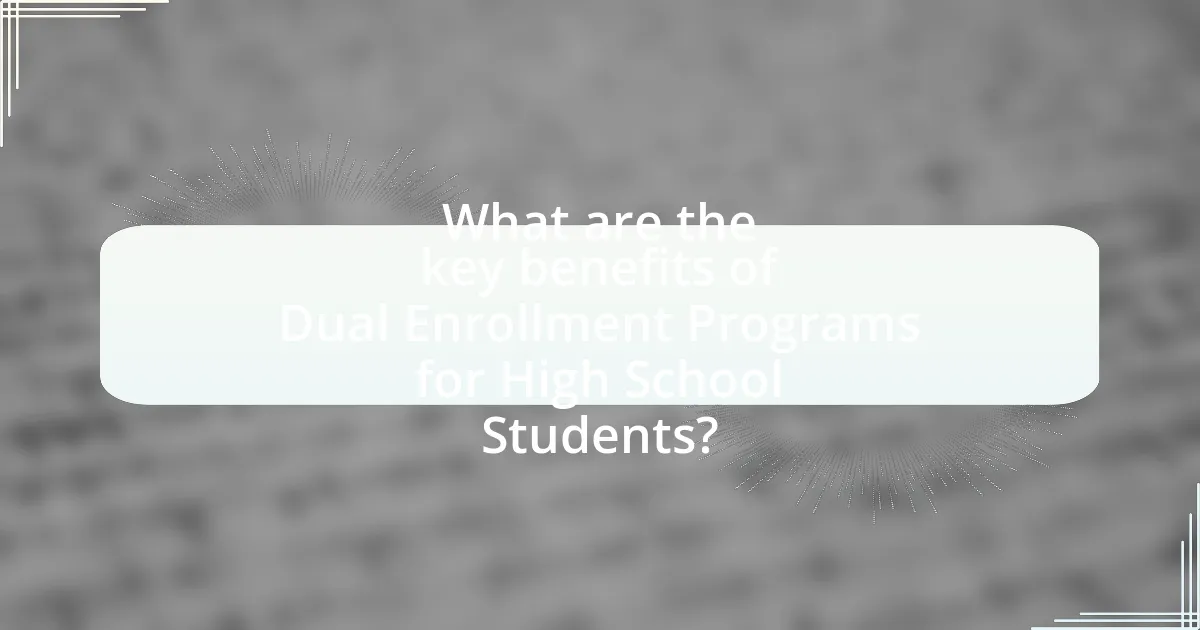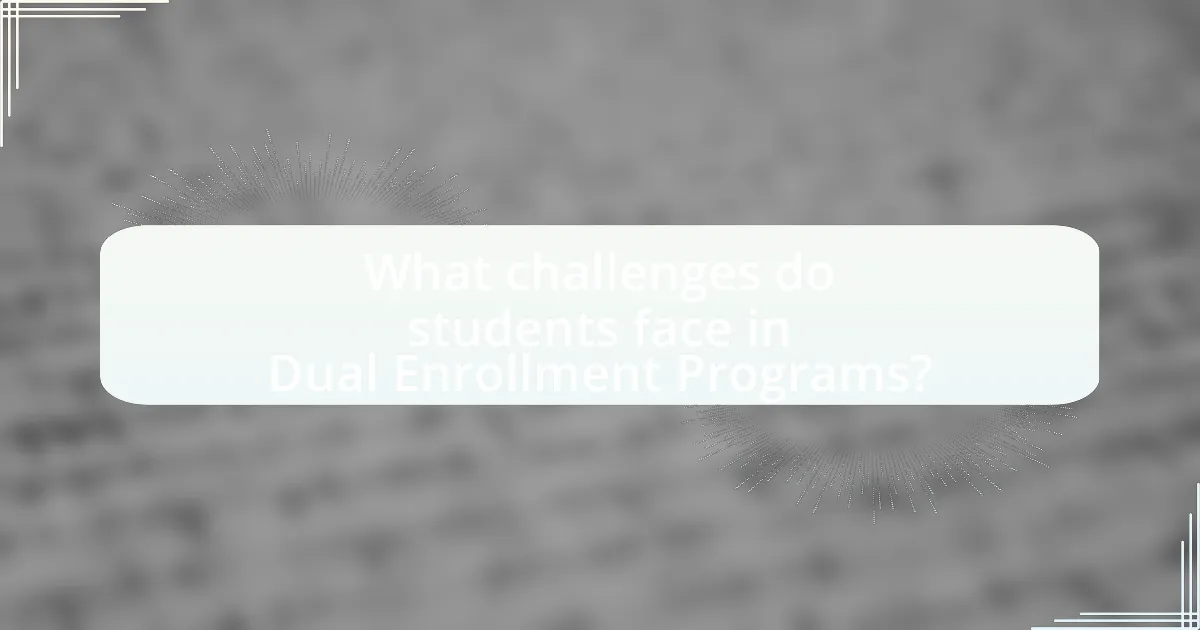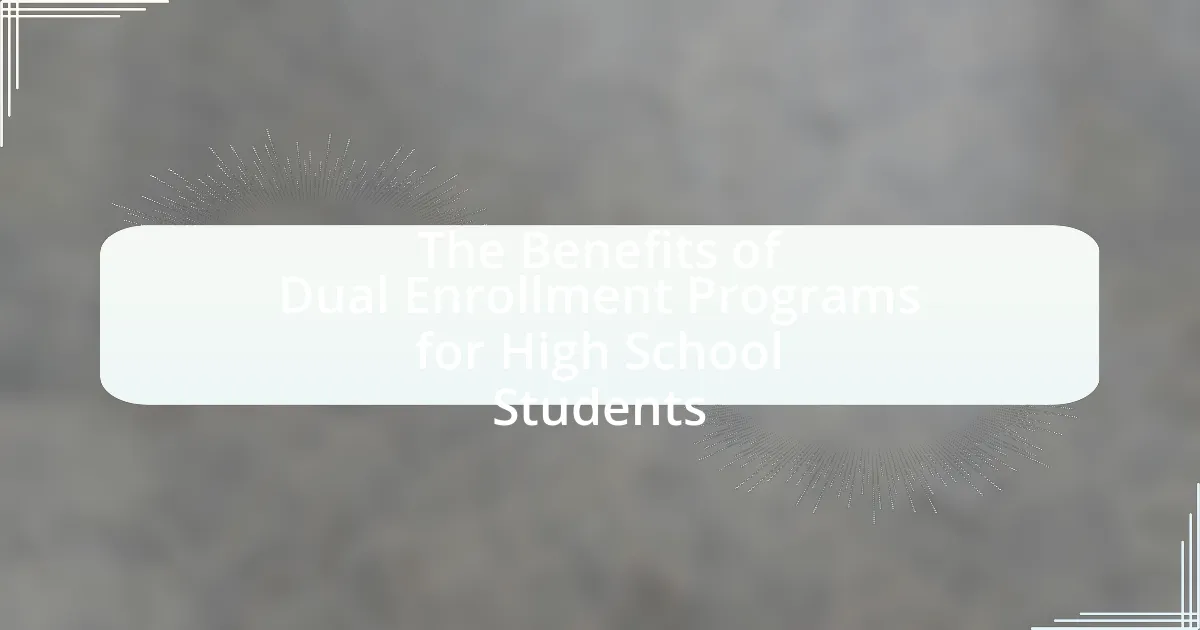Dual Enrollment Programs for high school students enable them to take college-level courses while still enrolled in high school, allowing them to earn both high school and college credits simultaneously. These programs, often established through partnerships between high schools and local colleges, have gained popularity due to their potential to enhance academic performance, increase college readiness, and reduce overall educational costs. The article explores the functioning of these programs, the types of courses offered, eligibility criteria, benefits for students, and the challenges they may face. Additionally, it discusses the financial advantages and support systems available, as well as best practices for students considering participation in dual enrollment.

What are Dual Enrollment Programs for High School Students?
Dual Enrollment Programs for high school students allow them to take college-level courses while still enrolled in high school, earning both high school and college credits simultaneously. These programs are typically offered through partnerships between high schools and local colleges or universities, providing students with the opportunity to experience college coursework and potentially reduce the time and cost of obtaining a college degree. Research indicates that students who participate in dual enrollment programs often demonstrate higher academic performance and increased likelihood of pursuing higher education compared to their peers who do not participate.
How do Dual Enrollment Programs function?
Dual Enrollment Programs function by allowing high school students to enroll in college courses and earn both high school and college credit simultaneously. These programs typically involve partnerships between high schools and local colleges or universities, enabling students to access college-level coursework while still completing their high school education. According to the National Center for Education Statistics, in the 2018-2019 academic year, approximately 1.4 million high school students participated in dual enrollment programs, highlighting their growing prevalence and acceptance in the educational landscape.
What types of courses are typically offered in Dual Enrollment Programs?
Dual Enrollment Programs typically offer a variety of courses, including college-level general education classes, advanced placement courses, vocational training, and specialized subjects such as STEM (Science, Technology, Engineering, and Mathematics) and humanities. These programs allow high school students to earn college credits while still in high school, providing them with an opportunity to experience college coursework and potentially accelerate their education. According to the National Center for Education Statistics, over 80% of high schools in the United States offer dual enrollment options, reflecting the growing trend of integrating high school and college curricula.
Who is eligible to participate in Dual Enrollment Programs?
High school students are eligible to participate in Dual Enrollment Programs. These programs typically require students to meet specific academic criteria, such as maintaining a minimum GPA and obtaining permission from their parents and school counselors. Additionally, students often need to demonstrate readiness for college-level coursework through standardized test scores or placement tests.
Why are Dual Enrollment Programs becoming popular?
Dual Enrollment Programs are becoming popular due to their ability to provide high school students with the opportunity to earn college credits while still in high school. This trend is driven by the increasing demand for advanced educational pathways that enhance college readiness and reduce the overall cost of higher education. According to the National Center for Education Statistics, participation in dual enrollment programs has grown significantly, with over 1.4 million high school students enrolled in such programs in recent years. This growth reflects a broader recognition of the benefits these programs offer, including improved academic performance, increased graduation rates, and better preparation for post-secondary education.
What factors contribute to the growth of Dual Enrollment Programs?
The growth of Dual Enrollment Programs is primarily driven by increasing demand for college readiness among high school students. This demand is fueled by the desire for students to gain early exposure to college-level coursework, which can enhance their academic skills and improve their chances of post-secondary success. Additionally, financial incentives play a significant role; many programs offer reduced tuition rates or even free college credits, making higher education more accessible. According to the National Center for Education Statistics, enrollment in dual enrollment programs has increased significantly, with over 1.4 million high school students participating in such programs in recent years. This trend reflects a broader recognition of the value of dual enrollment in bridging the gap between high school and college, thereby contributing to its growth.
How do educational institutions benefit from offering Dual Enrollment Programs?
Educational institutions benefit from offering Dual Enrollment Programs by increasing student enrollment and enhancing academic reputation. These programs attract high school students who seek college-level coursework, thereby boosting the institution’s enrollment numbers. Additionally, research from the National Center for Education Statistics indicates that institutions with dual enrollment programs often experience higher graduation rates and improved academic performance among participants, which enhances their overall reputation. Furthermore, these programs can lead to increased funding opportunities, as many states provide financial incentives for institutions that support dual enrollment initiatives.

What are the key benefits of Dual Enrollment Programs for High School Students?
Dual Enrollment Programs provide high school students with the opportunity to earn college credits while still in high school, which can lead to significant academic and financial benefits. These programs allow students to experience college-level coursework, enhancing their academic preparedness and increasing their chances of success in higher education. Additionally, students can save on college tuition costs by completing credits early, as many dual enrollment courses are offered at reduced rates or even for free. Research indicates that students who participate in dual enrollment are more likely to graduate from high school and enroll in college, with studies showing that they often achieve higher GPAs in college compared to their peers who did not participate in such programs.
How do Dual Enrollment Programs enhance academic performance?
Dual Enrollment Programs enhance academic performance by allowing high school students to take college-level courses, which increases their exposure to advanced material and academic rigor. Research indicates that students participating in dual enrollment are more likely to graduate from high school and enroll in college compared to their peers who do not participate. A study by the National Center for Education Statistics found that dual enrollment students had higher GPAs and were more likely to complete a college degree within three years of high school graduation. This exposure to college coursework not only prepares students for the demands of higher education but also fosters critical thinking and time management skills essential for academic success.
What evidence supports improved academic outcomes for students in Dual Enrollment Programs?
Evidence supports improved academic outcomes for students in Dual Enrollment Programs through various studies indicating higher college enrollment rates and better academic performance. For instance, a study by the Community College Research Center found that students participating in dual enrollment were 10% more likely to enroll in college immediately after high school compared to their peers. Additionally, research published in the Journal of Educational Psychology showed that dual enrollment students had higher GPAs in college, with an average increase of 0.5 points compared to non-participants. These findings demonstrate that dual enrollment programs effectively enhance academic readiness and success for high school students.
How do these programs prepare students for college-level coursework?
Dual enrollment programs prepare students for college-level coursework by providing them with the opportunity to take college classes while still in high school. These programs expose students to the rigor and expectations of college academics, helping them develop essential skills such as critical thinking, time management, and independent study habits. Research indicates that students who participate in dual enrollment are more likely to succeed in college, as they have already navigated the challenges of higher education environments. For instance, a study by the National Center for Education Statistics found that dual enrollment students had higher college completion rates compared to their peers who did not participate in such programs.
What financial advantages do Dual Enrollment Programs provide?
Dual Enrollment Programs provide significant financial advantages by allowing high school students to earn college credits at reduced or no cost. This cost-saving opportunity can lead to lower tuition expenses when students eventually enroll in college, as they may enter with credits already completed. According to the National Center for Education Statistics, students who participate in dual enrollment can save an average of $10,000 on college tuition by completing courses while still in high school. Additionally, these programs often reduce the time needed to complete a degree, further decreasing overall educational expenses.
How can Dual Enrollment Programs reduce college tuition costs for students?
Dual Enrollment Programs can reduce college tuition costs for students by allowing them to earn college credits while still in high school, effectively decreasing the number of credits needed to graduate from college. By participating in these programs, students can complete introductory college courses at a significantly lower cost, often free or at a reduced rate compared to traditional college tuition. For instance, a study by the National Center for Education Statistics found that students who participated in dual enrollment programs saved an average of $1,500 on college tuition. This financial benefit arises because students can enter college with credits already completed, leading to shorter time spent in college and reduced overall tuition expenses.
What scholarships or financial aid opportunities are available for Dual Enrollment students?
Dual Enrollment students can access various scholarships and financial aid opportunities, including state-funded grants, institutional scholarships from participating colleges, and federal financial aid programs like the Pell Grant. Many states offer specific scholarships aimed at supporting Dual Enrollment students, such as the Florida Bright Futures Scholarship, which provides funding based on academic achievement. Additionally, some colleges have their own scholarship programs specifically designed for high school students enrolled in Dual Enrollment courses, which can cover tuition costs or provide stipends for educational expenses. These financial resources are intended to alleviate the financial burden of college courses taken during high school, making higher education more accessible.

What challenges do students face in Dual Enrollment Programs?
Students in Dual Enrollment Programs face several challenges, including academic pressure, time management issues, and potential lack of support. The academic rigor of college-level courses can overwhelm high school students, leading to stress and anxiety. Additionally, balancing high school responsibilities with college coursework often results in time management difficulties, as students must navigate competing priorities. Furthermore, many students may not receive adequate guidance or support from their high schools or colleges, which can hinder their ability to succeed in these programs. Research indicates that these challenges can impact students’ overall performance and retention in dual enrollment courses.
How can students manage the workload of Dual Enrollment Programs?
Students can manage the workload of Dual Enrollment Programs by implementing effective time management strategies and utilizing available resources. Prioritizing tasks and creating a structured schedule helps students allocate sufficient time for both high school and college coursework. Research indicates that students who use planners or digital calendars report higher academic performance, as they can visualize deadlines and commitments. Additionally, seeking support from teachers, academic advisors, and peers can provide guidance and assistance, further alleviating the workload. Engaging in study groups and utilizing tutoring services can enhance understanding of complex subjects, making it easier to balance responsibilities.
What strategies can help students balance high school and college courses?
Students can balance high school and college courses by implementing effective time management strategies. Prioritizing tasks through a planner or digital calendar allows students to allocate specific time blocks for studying, attending classes, and completing assignments. Research indicates that students who use structured schedules report higher academic performance and lower stress levels. Additionally, establishing a consistent routine helps students maintain focus and manage their workload effectively. Engaging in regular communication with teachers and college professors can also provide clarity on expectations and deadlines, further aiding in the balancing act.
What support systems are available for students in Dual Enrollment Programs?
Students in Dual Enrollment Programs have access to various support systems, including academic advising, tutoring services, and counseling resources. Academic advising helps students navigate course selections and understand college requirements, while tutoring services provide assistance in specific subjects to enhance academic performance. Counseling resources offer emotional and psychological support, ensuring students manage the challenges of balancing high school and college coursework effectively. These support systems are crucial for fostering student success and retention in dual enrollment programs.
What are the potential drawbacks of Dual Enrollment Programs?
Potential drawbacks of Dual Enrollment Programs include the risk of students becoming overwhelmed by the increased academic demands, which can lead to lower performance in both high school and college courses. Research indicates that students may struggle to balance the workload, resulting in stress and potential burnout. Additionally, there can be a lack of adequate support systems for dual enrollment students, which may hinder their success. A study by the National Center for Education Statistics found that students in dual enrollment programs often face challenges in transitioning to college-level expectations, impacting their overall academic experience.
How might Dual Enrollment Programs impact a student’s high school experience?
Dual Enrollment Programs significantly enhance a student’s high school experience by providing access to college-level coursework while still in high school. This exposure allows students to earn college credits, which can lead to advanced placement in college and potentially reduce the time and cost of obtaining a degree. Research from the National Center for Education Statistics indicates that students who participate in dual enrollment are more likely to enroll in college and complete their degrees compared to their peers who do not participate. Additionally, these programs foster academic rigor and improve students’ readiness for post-secondary education by developing critical thinking and time management skills.
What are the risks of students taking on too much responsibility too early?
Students taking on too much responsibility too early face several risks, including increased stress, burnout, and hindered academic performance. When students juggle excessive responsibilities, they may struggle to manage their time effectively, leading to anxiety and a decline in mental health. Research indicates that high school students involved in dual enrollment programs often experience heightened pressure due to balancing college-level coursework with their existing commitments. A study published in the Journal of Educational Psychology found that students who reported high levels of responsibility were more likely to experience negative emotional outcomes, such as depression and anxiety. Additionally, taking on too much responsibility can detract from their ability to engage fully in their educational experiences, ultimately impacting their academic success and personal development.
What best practices should students follow when considering Dual Enrollment Programs?
Students should research and understand the requirements and implications of Dual Enrollment Programs before participating. This includes reviewing eligibility criteria, course offerings, and potential impacts on high school graduation and college credit. For instance, students should consult with academic advisors to ensure that the courses align with their educational goals and that they meet any prerequisites. Additionally, students should consider their workload and time management skills, as balancing high school and college courses can be challenging. According to the National Center for Education Statistics, students who participate in dual enrollment are more likely to enroll in college and complete their degrees, highlighting the importance of making informed decisions about course selection and commitment.

Leave a Reply